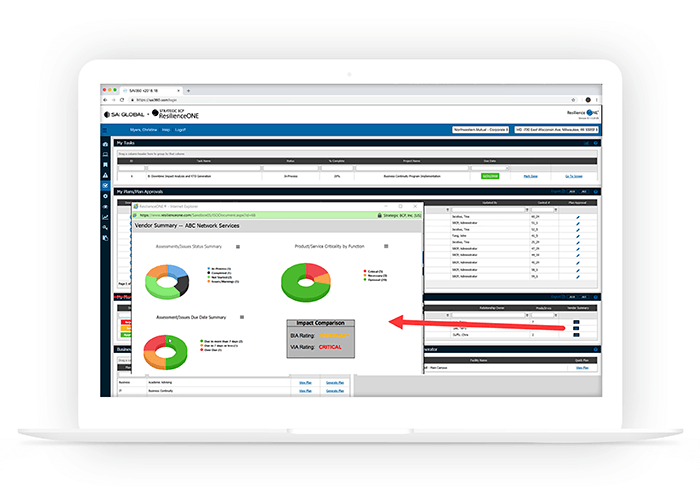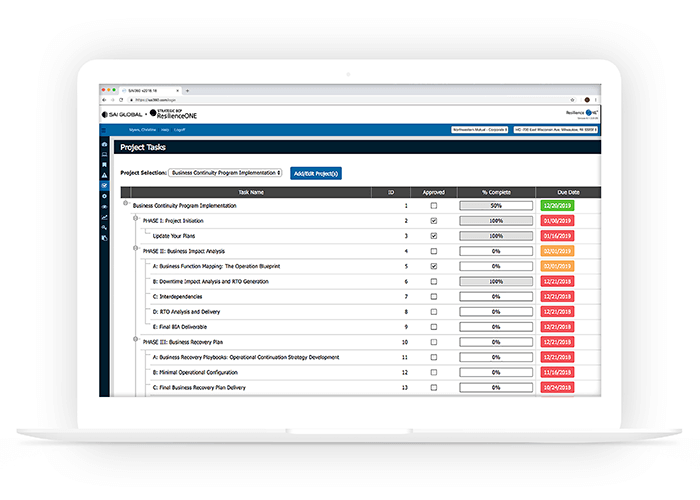
Automate your business continuity program with ResilienceONE by SAI Global

Disasters can strike a business at any given moment, and service outages or disruption could cost companies millions in revenue, or worse, lead to customer trust evaporating. Given the ultra-competitive marketplace driving the digital economy, it may not take much for customers to move their business to a competitor if the organization fails to deliver the product or service expected. Which is precisely why companies need robust business continuity management (BCM) processes in place to safeguard their business in the event of a catastrophe.
Business continuity, in a nutshell, is the ability of company to maintain critical business functions even in the event of natural disaster, IT infrastructure crash, data breach, geopolitical uncertainties, or any other type of outage. BCM typically involves understanding which processes and departments are essential to business operations, development and execution of contingency strategies, and testing of plans to ensure gaps are found and mitigated before an undesired incident occurs.
Naturally, a comprehensive BCM program includes risk mitigation, security, emergency response, crisis management, and recovery to enable businesses to deliver a minimum acceptable service without violating their SLAs. Furthermore, an increasing number of governments and regulatory bodies require enterprises, specifically those in critical industries such as finance and healthcare, to adapt BCM processes as a contractual obligation.
While business leaders need to commit to implementing an effective BCM initiative, the quandary faced is should a policy should be created & implemented internally, or should outside help to be sought? Few organizations have the resources to start a new tranche of recruitment for the purpose, so it would need to be a case of reallocating staff, and possibly retraining them; in itself carrying no small cost.
Let’s look at some of the considerations that need to be thought about, whichever way your organization might go.
Developing an effective BCM strategy
A comprehensive BCM program should include risk mitigation, security continuance, emergency response methods, crisis management frameworks & guides, and an overall recovery element to deliver a minimum acceptable service without violating any SLAs. Accordingly, it requires an organization-wide approach, that will involve all personnel at some stage.
While it may be tempting to push this process to IT entirely, BCM is indubitably a business issue, and everyone within the company needs to own it.

Source: SAI Global
Organizations also need to be aware of the latest external laws, guidelines, and standards pertaining to BCM. In today’s environment that means data protection in the short term when a disaster strikes, and ongoing data security throughout a recovery cycle.
A crisis management plan lays out protocols for handling business processes, communications, and relationships with customers during and, in some cases, immediately after disaster strikes. These protocols should spell out how critical process will be restored to get the business back up and running again.
When all the appropriate plans are established, companies must continue to monitor, test and improve their BCM plan, to ensure their strategy stays current and is adjusted for latest changes within the organization, and across the industry.
If for example, your business has a newly-expanded division or has merged with another organization, has the BCM plan been amended? A continuous system of reappraisal will not only help recovery times, but will also highlight extant security issues or operational flaws.
That ongoing commitment might lead many to a third-party supplier capable of managing complex BCM plans in an automated way rather than manually. Many companies looking to automate turn to ResilienceONE from SAI Global. Its insights and experience significantly cut through the time taken to provide solid business continuity frameworks.
An automated, scalable and integrated approach to BCM
Businesses understand that poor management of continuity efforts will not only slow recovery processes from significant disruption but could even make the problem worse and perhaps even irreversible. However, with a Business Continuity Management solution such as ResilienceOne, businesses can leverage next-gen governance, risk management, and compliance efforts in a scalable and integrated framework. The solution can also provide out-of-the-box reports and dashboards, automation rules, and surveys (also available on mobile app); that loops us back to that on-going reassessment of business continuity planning that’s so necessary in this interconnected business landscape.
Ensuring employee buy-in for any technology is paramount for its adoption and acceptance. For a BCM solution, that usability needs to extend right up to C-Suite personnel. A user-friendly GUI makes stakeholders’ participation in email surveys, incident reporting and exception management intuitive and straightforward. That enables more comprehensive and more importantly, accurate assessments.

Source: SAI Global
ResilienceONE creates a sound framework for organizations’ business continuity (BC) practices to transform Business Continuity Management programs. It is a complete cloud solution that supports the return to business-as-usual so companies can maintain their confidence through even the most unusual events.
ResilienceONE manages risk, BC, and resilience. It can be deployed in just five business days, with a user interface built with infrequent use in mind, so it’s easy to use when the need arises. ResilienceONE also provides a blueprint for your organization’s successful recovery regardless of incident type. It brings task automation, risk analytics, visualization tools, and dashboards into an enterprise command center. With powerful features, you can address global threats and outages quickly and cost-effectively— without long implementations or additional investment.
Improve business performance with timely compliance
Beyond preparing for the worst-case-scenario, businesses also stand to benefit from proactively ensuring compliance by leveraging a BCM platform’s ability to adhere to transnational frameworks and regulation. SAI Global’s Integrated Risk Management solutions do just that, as an out-of-the-box feature.
The solution helps companies to quickly measure risks and check for compliance with thousands of requirements and controls in a common control and risk framework. Because of the inter-system integrations, the impact and risk analysis, along with all insights, are gathered within a single system of record; that reduces error and eases the headache of risk reporting.
Among other red tape that needs to be navigated in international business, control frameworks including ITIL, COBIT, NIST, ISO 27001, ISO 31000, and PCI remain a worry, especially when the organization is put under strain after an incident. With the SAI Global solution, the platform’s controls are pre-mapped to regulatory frameworks for a “test once, comply many” automated efficiency.
BCM solutions are no longer a luxury reserved for a few, but a strategic imperative for progressive companies to proactively identify and mitigate their risk of exposure to internal and external threats.
Companies have to return to “business as usual” after significant incidents, but also remain resilience in all activities, proactively.
To learn more about SAI Global’s long and successful track record implementing governance, risk, and compliance products, get in touch now. Or request a demo of SAI Global’s ResilienceONE BCM solution.
READ MORE
- The criticality of endpoint management in cybersecurity and operations
- Ethical AI: The renewed importance of safeguarding data and customer privacy in Generative AI applications
- How Japan balances AI-driven opportunities with cybersecurity needs
- Deploying SASE: Benchmarking your approach
- Insurance everywhere all at once: the digital transformation of the APAC insurance industry
